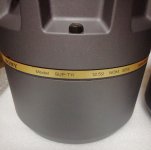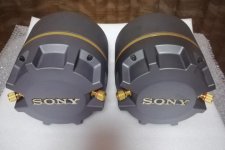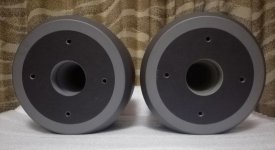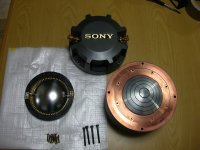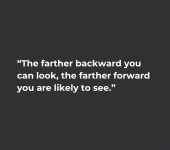Unless I am missing something on the site I couldn't find a single measurement. Without measurements to back it up I would count the claims as marketing and be skeptical about those claims. If there are measurements I missed can someone post a link?
Rob 🙂
I've seen the proof, but won't break obligations.
That's another difference between Western and Japanese culture, in the latter case making bold claims that are not true will be held against you.
marco_gea already posted the plots from a Japanese comparison test in the past, in which the Sony SUP-T11 proved superior to the TAD TD-4001 and the JBL 2446J.
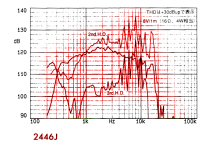
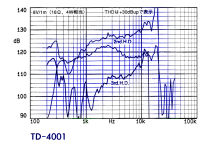
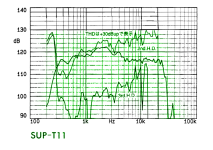
The G.T. Sound GSU-D04R is loosely based on the later (and better) Sony SUP-T11G version, but improved considerably.
This is their previous model (GSU-D04):
Last edited:
The G.T. Sound GSU-D04R is loosely based on the later (and better) Sony SUP-T11G version, but improved considerably.
Than why not post the measurements? That looks good to bad it's not the "improved" driver. Smoother lower distortion, cleaner CSD, higher sensitivity, better power handling? Would be nice to know.
People tend to (sometimes blindly) trust science.
If you delve into Japanese, Korean, Taiwanese and increasingly Chinese audio culture, it becomes clear that it is often people at the top of the technical/scientific/industrial pyramid who have become 'aware' of the fact that audio (reproduction) is inherently chaotic and subjective quality is largely dominated by non-linear phenomena.
Measurements are repeatable and when standardized can be a very useful comparison tool. The flip side is you have people blindly following gurus. The most inherently chaotic and subjective quality in audio are our own biases so basically the listener. They are just as human as we are.
The premise that Be and Ti don't make music is at best a bias that I don't think many would agree with. I have used Be, Ti, Al and Mg compression drivers and you know what? They all made music.
YMMV
Rob 🙂
Duralumin is just a old fashioned/fancy word for what is today commonly known as: 2024 Aluminium alloy.This is a Japanese Duraluminium remake, similar to the diaphragms of the 594A: lighter, stronger, BETTER:
Might have been used another variant of the 20xx family of alu alloys for some mfgs.
It is lighter only because it's thickness is less, likely stiffer due to different heat treat, but higher stiffness generally also means more prone to fatigue.
The main alloy material is Cu (4-5%) which heavier then Alu., so Duralumin is actually heavier then aluminium by a slight bit.
The other additives is Magnesium and Manganese 0,5-1%.
It's main benefit is that is is stronger and tougher mechanically, then a pure Alu.. diaphragm would be, it will also take longer to fatigue, and it take well to heat treatment for adjusting ductility and hardness.
But it is a hell to solder or weld.
If you dig around that is the same material JBL used in they're old "Aluminum" diaphragms, used in the 2420, 2440, 375 etc. Which they eventually coined Aluminum alloy (old JBL datasheets 2420 for ref.)
Also note the 375 used the D16R2440 diaphragm.
And likely Radians aluminum alloy diaphragms are of a similar alloy.
So both of those diaphragms are made from the same material in fact🙂
Different foundries will have different trace elements and slight % change in the alloy as usual.
The newer Japanese diaphragms are better finished/polished and maybe coated for longevity, as Duralumin is more prone to corrosion due to the added copper and MG then regular aluminium.
Attachments
Last edited:
The suspension is made from BeCU = Beryllium copper, which contains ca. 97% copper, and 1-3% beryllium.Yamaha 6681B (aluminum diaphragm/beryllium "finger" suspension)
It is often found as battery holders in remotes fx.
Fairly soft and brittle actually, well suited for springs of a limited life cycle.
There is a reason why the suspension is usually what gets destroyed on them.
marco_gea already posted the plots from a Japanese comparison test in the past, in which the Sony SUP-T11 proved superior to the TAD TD-4001 and the JBL 2446J.
Attachments
f you dig around that is the same material JBL used in they're old "Aluminum" diaphragms, used in the 2420, 2440, 375 etc. Which they eventually coined Aluminum alloy (old JBL datasheet for ref.)
Wouldn't that be the same for Altec as well?
Rob 🙂
The suspension is made from BeCU = Beryllium copper, which contains ca. 97% copper, and 1-3% beryllium.
It is often found as battery holders in remotes fx.
Fairly soft and brittle actually, well suited for springs of a limited life cycle.
There is a reason why the suspension is usually what gets destroyed on them.
Hello
Back in the day I was a die setter and used compound dies to manufacture electrical contacts. We used to manufacture BeCu contacts by the 10's of thousands. The actual material as supplied is soft and malleable for easy forming and unusable right out of the die. They had to be degreased and then heat treated. After heat treat they became stiff and springlike. They can last for thousands of cycles as spring contacts and we would test them for deformation under load as part of acceptance testing on the finished product.
Do they heat treat the surrounds? They could have quite restoring force after being compressed depending on the shape and geometry during forming.
Rob 🙂
Last edited:
Some phase plugs may suit certain horns better than others, regardless of the design date.FWIW, one horn designer said of Radian drivers that the phase plugs are outdated, and the Be diaphragms are embossed.
This Radian 750NEOBe diaphragm doesn't appear to be embossed:
Felt is used as a damping material in many compression driver back chambers.Also, what is the felt inside used for and why was it missing?
Not familiar with Radian's back chamber damping or the driver in question.
Art
Measurements are repeatable and when standardized can be a very useful comparison tool. The flip side is you have people blindly following gurus. The most inherently chaotic and subjective quality in audio are our own biases so basically the listener. They are just as human as we are.
This reminds me first and foremost of a certain forum that pretends to be 'scientific'.
I completely agree with the 2nd comment. People (especially on that forum) often seem to willfully forget that Toole himself explicitly puts subjective preferences first.
The premise that Be and Ti don't make music is at best a bias that I don't think many would agree with. I have used Be, Ti, Al and Mg compression drivers and you know what? They all made music.
As indicated under the relevant quote, these are not necessarily my own opinions.
Although I recognize many 'observations' from the Asian communities, I don't share them all.
In Asia, a lot of attention is usually paid to reproduction of mid/highs.
Whereas in the US (and Germany), the focus often seems to be centered around low frequency reproduction.
This reminds me first and foremost of a certain forum that pretends to be 'scientific'.
I completely agree with the 2nd comment. People (especially on that forum) often seem to willfully forget that Toole himself explicitly puts subjective preferences first.
Well yeah the bottom line is "Do you like it?" Just because you do, someone else may not. I like Toole's work and an attempt to understand how we tick and bridge the two sides. Either extreme doesn't work. IMHO You need a healthy dose of both.
Rob 🙂
I've posted additional info in camplo's thread.
(Btw, I no longer endorse my comments in post #3,128)
Personally, I think Jim Lansing is probably the most underrated genius in audio.Well yeah the bottom line is "Do you like it?" Just because you do, someone else may not. I like Toole's work and an attempt to understand how we tick and bridge the two sides. Either extreme doesn't work. IMHO You need a healthy dose of both.
Rob 🙂
However, after going through hundreds of pages of Bell Labs research literature last week, the mind boggling amount of physics/scientific know how within Western Electric (Wente, Thuras and others) also commands a lot of respect. It reads like the papers of Audio Precision, Klippel and Brüel & Kjær combined, but seemingly straight from the universe.
Last edited:
Duralumin is just a old fashioned/fancy word for what is today commonly known as: 2024 Aluminium alloy.
Might have been used another variant of the 20xx family of alu alloys for some mfgs.
It is lighter only because it's thickness is less, likely stiffer due to different heat treat, but higher stiffness generally also means more prone to fatigue.
The main alloy material is Cu (4-5%) which heavier then Alu., so Duralumin is actually heavier then aluminium by a slight bit.
The other additives is Magnesium and Manganese 0,5-1%.
It's main benefit is that is is stronger and tougher mechanically, then a pure Alu.. diaphragm would be, it will also take longer to fatigue, and it take well to heat treatment for adjusting ductility and hardness.
But it is a hell to solder or weld.
If you dig around that is the same material JBL used in they're old "Aluminum" diaphragms, used in the 2420, 2440, 375 etc. Which they eventually coined Aluminum alloy (old JBL datasheets 2420 for ref.)
Also note the 375 used the D16R2440 diaphragm.
And likely Radians aluminum alloy diaphragms are of a similar alloy.
So both of those diaphragms are made from the same material in fact🙂
Different foundries will have different trace elements and slight % change in the alloy as usual.
The newer Japanese diaphragms are better finished/polished and maybe coated for longevity, as Duralumin is more prone to corrosion due to the added copper and MG then regular aluminium.
You probably know that when you delve into metallurgy, you discover a whole universe with countless subtle details that can make a big difference.
Your last sentence contains 'some' truth.
Last edited:
FWIW, one horn designer said of Radian drivers that the phase plugs are outdated, and the Be diaphragms are embossed.
For now, assuming that entire statement is untrue, for those wishing to use Radian Be drivers, I found this from Docali about the assembly issues that caused an unnecessary response peak. Luckily, he was able to banish by somehow reseating (?) the diaphragm. Also, what is the felt inside used for and why was it missing? Seems all pretty careless of Radian designers. https://www.diyaudio.com/community/threads/18-sound-nd3st-compression-driver.300974/page-3 post 41. But I'm very sure that Pierre caught those oversights with his build.
Phase difference & Radian(s)

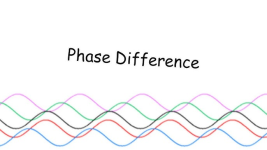
Corrected for Re (I used the specified minimum impedance for the RCF = 8.5 Ohm) the motor strength of the RCF is even higher than that of the GSU-D04R, a 12.5 Ohm driver.Would need to increase the RCF ND950's Bl from 17.6 to 20 and double the back chamber volume to get there.
It was a mistake for me to equate Bl of coils with different impedance and lengths.
According to the specifications, the RCF ND950's neodymium magnet strength is 2.0 Tesla, the same as the much heavier Alnico magnet GSU-D04R's 20,000 Gauss.
If we look at the JBL 2446, a driver that uses the near same magnet strength (1.9 Tesla/19,000 Gauss) available in an 8 ohm ("H") and 16 ohm ("J") version, we find motor strength is equal for both, even though the minimum impedance and Bl are not:

Corrected for Re:
Bl factor for the "H" squared, 12.7x12.7=161.29/6(minimum impedance)=26.88.
Bl factor for the "J" squared, 18x18=161.29/12 (minimum impedance)=27.00, only 0.12 difference in motor strength.
According to the specifications, the RCF ND950's neodymium magnet strength is 2.0 Tesla, the same as the much heavier Alnico magnet GSU-D04R's 20,000 Gauss.
If we look at the JBL 2446, a driver that uses the near same magnet strength (1.9 Tesla/19,000 Gauss) available in an 8 ohm ("H") and 16 ohm ("J") version, we find motor strength is equal for both, even though the minimum impedance and Bl are not:
Corrected for Re:
Bl factor for the "H" squared, 12.7x12.7=161.29/6(minimum impedance)=26.88.
Bl factor for the "J" squared, 18x18=161.29/12 (minimum impedance)=27.00, only 0.12 difference in motor strength.
G.T. Sound GSU-04R: 32.
RCF ND950: 36.44.
In the meantime I've found some additional details of the Sony SUP-T11.
As expected, the diaphragm is the most important part, although the entire driver is carefully designed.
Many diaphragms are integrally formed with a suspension consisting of a metal sheet. In order to maintain a degree of durability and rigidity required by the suspension, the metal sheet is thicker and thus heavier than that of a diaphragm with separate suspension. This often leads to poor frequency and response characteristics.
The aluminum dome + titanium suspension of the SUP-T11 weighs only 2.3g.
The engineers found that the thickness of the dome and (integrated) coil (bobbin) must be 70% or less of a thickness equivalent in mechanical strength to the thickness of the suspension material in order to achieve the improved frequency characteristics.
The response in the Sony brochure looks similar to the factory plot of the GSU-D04R, despite the smoothing:

The diaphragm without suspension looks like this:

RCF ND950: 36.44.
In the meantime I've found some additional details of the Sony SUP-T11.
As expected, the diaphragm is the most important part, although the entire driver is carefully designed.
Many diaphragms are integrally formed with a suspension consisting of a metal sheet. In order to maintain a degree of durability and rigidity required by the suspension, the metal sheet is thicker and thus heavier than that of a diaphragm with separate suspension. This often leads to poor frequency and response characteristics.
The aluminum dome + titanium suspension of the SUP-T11 weighs only 2.3g.
The engineers found that the thickness of the dome and (integrated) coil (bobbin) must be 70% or less of a thickness equivalent in mechanical strength to the thickness of the suspension material in order to achieve the improved frequency characteristics.
The response in the Sony brochure looks similar to the factory plot of the GSU-D04R, despite the smoothing:
The diaphragm without suspension looks like this:
Last edited:
In my opinion, the ND950 lends itself very well to some (de)tuning, which could approach the GSU-D04R/SUP-T11 properties. I have some ideas, but in light of the Japanese exotics, I'll first share some quotes from a comparison of a number of exotic/vintage drivers, including the Sony SUP-T11.
"Conclusion from the initial test results: if you desire the most uncompromising acoustics in the world, pick the Sony SUP-L11, if you want the most popular and widely accepted, then choose the TAD TL-1601a. The most universal acoustics would be on the Fostex W400A-HR, and it will be good not only in direct radiation, but also loaded on a reverse horn! The most most accessible option, in terms of price / sound / the possibility to order an unlimited number, would be the Altec Lancing 515-8C, but, unfortunately, the new Altec from GPA is much inferior in sound to the old vintage Altec!
So, the woofer has been selected.
A bit of history...
It turns out that these speakers were not developed for sale at all (that's why they are the best!), but specifically for equipping Sony Music studios and Hollywood studios owned by Sony Corporation. Sony invested in full! All their resources and capabilities were thrown into developing studio monitors of the far-midfield. For the best studios - the best equipment! Acoustic systems were required that had no limitations in dynamics, transparency, no distortion noticeable to the ear and accurately reproducing the BSO (large symphony orchestra) in the studio, the exact repetition of the sound of the BSO was taken as the basis. And if the system reproduces the BSO indistinguishably, then it will reproduce everything!
As a result, not only the most advanced 15" woofer was developed, but also the most powerful and complex magnetic system, consisting of eight cobalt (Alnico V) rods installed instead of the core and an additional ring cobalt magnet that increases the density of the magnetic field and compensates for losses in the magnetic circuit. Assembly and adjustment of such a complex magnetic system required precision equipment and highly qualified personnel, it was only possible to produce no more than 2 - 4 speakers per month. The first samples of Sony SUP-L11 were manufactured in 1995, production lasted only two years (in 1997 Sony closed its professional audio division), and it is easy to calculate that during this time a very small number of speakers were produced.

Sony SUP-L11 & TAD TL-1601A
An even more perfect compression driver was made to complement such a perfect bass driver - Sony SUP-T11, but more on that later.
The next step was to make another line of low-frequency speakers - Sony SUP-L12 and Sony SUP-L14, 12 and 15 inches in diameter, respectively. These drivers were simpler in design and intended for different purposes
After testing the Sony SUP-L11, many sound engineers who had become accustomed over many years to speakers of conventional design (TAD TL-1601a, TAD TL-1601b, TAD TL-1601c, TAD TL-1603, JBL 2235H, JBL ME150HS, JBL 1400Nd, etc.) found it difficult to work with. Professionals claimed that such a sound could not be achieved in domestic and concert conditions, that recordings mixed on the Sony SUP simply could not be reproduced by any other acoustic system in the world! During the final mastering they needed to listen to the sound as it would be at a concert or in a good home system. Then it was decided to develop speakers “in the style” of TAD and JBL for mastering – the Sony SUP-L14.
The systems with SUP-L11 were used for live recordings: the BSO is in one room, and the control room is in another behind glass as it's necessary to control the mix during multi-track recording. Here the qualities of the Sony SUP-L11 proved to be irreplaceable, because it could best recreate the atmosphere of live instruments, which made it possible to record them absolutely correctly.
The question is: why were Sony speakers the best?
Firstly, in the 1990s, the Japanese corporation was one of the largest and most successful in the world (like Apple now) and could allocate an unlimited budget to develop the best product in its category.
Secondly, almost all 15" speakers were originally developed for professional purposes – sound reinforcement of concerts, clubs and open areas, and for these purposes, sound pressure and power are most important, not sound quality. Even dynamic heads recognized as some of the best, such as TAD TL-1601a, JBL 2235H, Altec Lancing 515-8C, etc., were originally developed for concerts or cinemas and then migrated to studios and home systems. And only the Sony SUP-L11 was produced specifically to achieve maximum sound quality.
Thirdly, Sony SUP-L11 are not commercial speakers, they were not developed for sale, but for internal use, they are not in brochures (note: they are), they never had a price tag and no one knows how much they really cost!
We have decided on the bass driver, it will be Sony SUP-L11. Measurements and listening have shown that these speakers can work up to 800 Hz, this means that we can make a two-way speaker system with them. But in order not to "reinvent the wheel" because everything has been invented in acoustics for a long time and there has not been a single new invention for the last 25 years, and apparently there is none in the near future, we decided to study the issue of Sony monitors in more detail.
In 1995-1997, the Sony SEM-5S and Sony SEM-5W studio monitors and several other models - about which it is almost impossible to find information, were released with the Sony SUP-L11 and Sony SUP-T11 drivers.
Sony SUP-T11 & TAD TD-4001
In the original Sony acoustic systems, the Sony SUP-L11 speaker worked up to 600 Hz, from where the compression driver took over, which was mounted to a specially shaped horn. The Sony SUP-T11 compression driver has been specifically designed for high-quality music reproduction and, like the Sony SUP-L11, has an unprecedented design.
The Sony SUP-T11 compression driver harbors unique capabilities like no other driver ever released. The closest competitor that was able to get a little closer to Sony was the TAD TD-4001. We also went through about 20 compression drivers (we will not list them all here). Thanks to a 4" coil, the Sony SUP-T11 is capable of operating from 450 Hz to 24 kHz! The TAD TD-4001: 450 Hz - 20 kHz and the JBL 476Be: 500 Hz - 16 kHz. And it is a shame for JBL, they were only able to make a 4" membrane from pure beryllium in the mid-2000s, while Pioneer has been producing TAD TD-4001 drivers since the early 1980s. Okay, JBL did it, but their 476Be installed in the JBL Everest DD 66000, JBL Everest DD 67000 do not pull the high frequencies at all and do not work as low as the TAD TD-4001.

Sony SUP-T11, TAD TD-4001 and a regular dome tweeter
What is the secret of the Sony SUP-T11? First of all, the precision magnetic system based on cobalt magnets and high-grade soft magnetic iron. The driver also featured an ultra-thin multilayer aluminum diaphragm made by spraying aluminum particles (Aluminium oxide or alumina) with a gold-plated suspension (gold is softer than aluminum and deforms better). An ultra-thin aluminum diaphragm, an elastic gold-plated suspension, a large volume of the compression chamber filled with a sound absorber made of foamed nickel, a zinc anti-resonance body - all this provides undistorted sound and a wide frequency range.
So, we have a pair of Sony SUP-L11 and Sony SUP-T11 drivers. Obviously, on these speakers we need to design something similar to what Sony engineers designed under the direction of Masaru Nagami. But we wanted to make the maximum version with two Sony SUP-L11s, and this speaker will be the only one, it cannot be bought or made to order.
Sony SUP-L11. Unique, the only magnetic system in the world with two magnets, where the external ring magnet "biases" or increases the coercive force of the internal cobalt rods when they are demagnetized by the EMF arising in the coil. A similar system was used in speakers with magnetization, only there the source of energy was an electromagnet drawing power from the electrical network.
The Sony SUP-L11 LF speaker is made with two-layer fiberglass and aluminum frame. We didn't want to have the weight of the Sony coil in our LF speaker, but we also didn't want to use flimsy, poorly cooled paper. We decided to make the frame out of titanium and cover it with thin paper where the winding would be placed. It's not for nothing that Sony covered the inside of the fiberglass frame with aluminum. It turns out that aluminum reduces the impact of Eddy currents. Our titanium frame also works like Sony's aluminum (titanium is a paramagnetic metal), only our frame is stronger, lighter and has ideal heat dissipation.
As a result, the speakers we developed not only met expectations, but also delighted with their naturalistic and engaging sound!"
I couldn't find an explicit reference to the project with the Sony drivers, but this seems plausible:

"Conclusion from the initial test results: if you desire the most uncompromising acoustics in the world, pick the Sony SUP-L11, if you want the most popular and widely accepted, then choose the TAD TL-1601a. The most universal acoustics would be on the Fostex W400A-HR, and it will be good not only in direct radiation, but also loaded on a reverse horn! The most most accessible option, in terms of price / sound / the possibility to order an unlimited number, would be the Altec Lancing 515-8C, but, unfortunately, the new Altec from GPA is much inferior in sound to the old vintage Altec!
So, the woofer has been selected.
A bit of history...
It turns out that these speakers were not developed for sale at all (that's why they are the best!), but specifically for equipping Sony Music studios and Hollywood studios owned by Sony Corporation. Sony invested in full! All their resources and capabilities were thrown into developing studio monitors of the far-midfield. For the best studios - the best equipment! Acoustic systems were required that had no limitations in dynamics, transparency, no distortion noticeable to the ear and accurately reproducing the BSO (large symphony orchestra) in the studio, the exact repetition of the sound of the BSO was taken as the basis. And if the system reproduces the BSO indistinguishably, then it will reproduce everything!
As a result, not only the most advanced 15" woofer was developed, but also the most powerful and complex magnetic system, consisting of eight cobalt (Alnico V) rods installed instead of the core and an additional ring cobalt magnet that increases the density of the magnetic field and compensates for losses in the magnetic circuit. Assembly and adjustment of such a complex magnetic system required precision equipment and highly qualified personnel, it was only possible to produce no more than 2 - 4 speakers per month. The first samples of Sony SUP-L11 were manufactured in 1995, production lasted only two years (in 1997 Sony closed its professional audio division), and it is easy to calculate that during this time a very small number of speakers were produced.
Sony SUP-L11 & TAD TL-1601A
An even more perfect compression driver was made to complement such a perfect bass driver - Sony SUP-T11, but more on that later.
The next step was to make another line of low-frequency speakers - Sony SUP-L12 and Sony SUP-L14, 12 and 15 inches in diameter, respectively. These drivers were simpler in design and intended for different purposes
After testing the Sony SUP-L11, many sound engineers who had become accustomed over many years to speakers of conventional design (TAD TL-1601a, TAD TL-1601b, TAD TL-1601c, TAD TL-1603, JBL 2235H, JBL ME150HS, JBL 1400Nd, etc.) found it difficult to work with. Professionals claimed that such a sound could not be achieved in domestic and concert conditions, that recordings mixed on the Sony SUP simply could not be reproduced by any other acoustic system in the world! During the final mastering they needed to listen to the sound as it would be at a concert or in a good home system. Then it was decided to develop speakers “in the style” of TAD and JBL for mastering – the Sony SUP-L14.
The systems with SUP-L11 were used for live recordings: the BSO is in one room, and the control room is in another behind glass as it's necessary to control the mix during multi-track recording. Here the qualities of the Sony SUP-L11 proved to be irreplaceable, because it could best recreate the atmosphere of live instruments, which made it possible to record them absolutely correctly.
The question is: why were Sony speakers the best?
Firstly, in the 1990s, the Japanese corporation was one of the largest and most successful in the world (like Apple now) and could allocate an unlimited budget to develop the best product in its category.
Secondly, almost all 15" speakers were originally developed for professional purposes – sound reinforcement of concerts, clubs and open areas, and for these purposes, sound pressure and power are most important, not sound quality. Even dynamic heads recognized as some of the best, such as TAD TL-1601a, JBL 2235H, Altec Lancing 515-8C, etc., were originally developed for concerts or cinemas and then migrated to studios and home systems. And only the Sony SUP-L11 was produced specifically to achieve maximum sound quality.
Thirdly, Sony SUP-L11 are not commercial speakers, they were not developed for sale, but for internal use, they are not in brochures (note: they are), they never had a price tag and no one knows how much they really cost!
We have decided on the bass driver, it will be Sony SUP-L11. Measurements and listening have shown that these speakers can work up to 800 Hz, this means that we can make a two-way speaker system with them. But in order not to "reinvent the wheel" because everything has been invented in acoustics for a long time and there has not been a single new invention for the last 25 years, and apparently there is none in the near future, we decided to study the issue of Sony monitors in more detail.
In 1995-1997, the Sony SEM-5S and Sony SEM-5W studio monitors and several other models - about which it is almost impossible to find information, were released with the Sony SUP-L11 and Sony SUP-T11 drivers.
Sony SUP-T11 & TAD TD-4001
In the original Sony acoustic systems, the Sony SUP-L11 speaker worked up to 600 Hz, from where the compression driver took over, which was mounted to a specially shaped horn. The Sony SUP-T11 compression driver has been specifically designed for high-quality music reproduction and, like the Sony SUP-L11, has an unprecedented design.
The Sony SUP-T11 compression driver harbors unique capabilities like no other driver ever released. The closest competitor that was able to get a little closer to Sony was the TAD TD-4001. We also went through about 20 compression drivers (we will not list them all here). Thanks to a 4" coil, the Sony SUP-T11 is capable of operating from 450 Hz to 24 kHz! The TAD TD-4001: 450 Hz - 20 kHz and the JBL 476Be: 500 Hz - 16 kHz. And it is a shame for JBL, they were only able to make a 4" membrane from pure beryllium in the mid-2000s, while Pioneer has been producing TAD TD-4001 drivers since the early 1980s. Okay, JBL did it, but their 476Be installed in the JBL Everest DD 66000, JBL Everest DD 67000 do not pull the high frequencies at all and do not work as low as the TAD TD-4001.

Sony SUP-T11, TAD TD-4001 and a regular dome tweeter
What is the secret of the Sony SUP-T11? First of all, the precision magnetic system based on cobalt magnets and high-grade soft magnetic iron. The driver also featured an ultra-thin multilayer aluminum diaphragm made by spraying aluminum particles (Aluminium oxide or alumina) with a gold-plated suspension (gold is softer than aluminum and deforms better). An ultra-thin aluminum diaphragm, an elastic gold-plated suspension, a large volume of the compression chamber filled with a sound absorber made of foamed nickel, a zinc anti-resonance body - all this provides undistorted sound and a wide frequency range.
So, we have a pair of Sony SUP-L11 and Sony SUP-T11 drivers. Obviously, on these speakers we need to design something similar to what Sony engineers designed under the direction of Masaru Nagami. But we wanted to make the maximum version with two Sony SUP-L11s, and this speaker will be the only one, it cannot be bought or made to order.
Sony SUP-L11. Unique, the only magnetic system in the world with two magnets, where the external ring magnet "biases" or increases the coercive force of the internal cobalt rods when they are demagnetized by the EMF arising in the coil. A similar system was used in speakers with magnetization, only there the source of energy was an electromagnet drawing power from the electrical network.
The Sony SUP-L11 LF speaker is made with two-layer fiberglass and aluminum frame. We didn't want to have the weight of the Sony coil in our LF speaker, but we also didn't want to use flimsy, poorly cooled paper. We decided to make the frame out of titanium and cover it with thin paper where the winding would be placed. It's not for nothing that Sony covered the inside of the fiberglass frame with aluminum. It turns out that aluminum reduces the impact of Eddy currents. Our titanium frame also works like Sony's aluminum (titanium is a paramagnetic metal), only our frame is stronger, lighter and has ideal heat dissipation.
As a result, the speakers we developed not only met expectations, but also delighted with their naturalistic and engaging sound!"
I couldn't find an explicit reference to the project with the Sony drivers, but this seems plausible:
- Home
- Loudspeakers
- Multi-Way
- Beyond the Ariel
